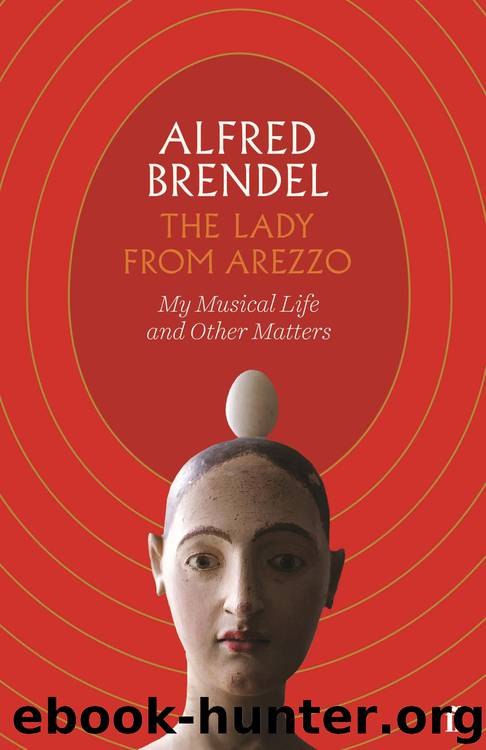The Lady from Arezzo by Alfred Brendel

Author:Alfred Brendel [Alfred Brendel]
Language: eng
Format: epub
ISBN: 9780571353736
Publisher: Faber & Faber
Published: 2019-12-16T16:00:00+00:00
Why has this question resulted in so much confusion? Part of the blame lies with the printed editions. Max Friedländer’s creditable one, probably the most frequently used for a long time, prints the semiquaver after the triplet. Even the edition graced with Fischer-Dieskau’s name, while trying to be accurate and generally having semiquavers underneath the last triplet note, misplaces the last semiquaver of bar 3. And the new Bärenreiter edition perpetuates the misleading visual picture, though it rightly mentions in a footnote that, as the sources suggest, adjustment of the rhythm is advisable. Rhythm is also a visual matter: the notation should help the player to grasp it at once with his eyes.
Gerald Moore, the celebrated accompanist, had stated categorically that the rhythm of ‘Wasserflut’ ‘should be played as it looks on the score’. The question is: on which score? If it is the manuscript and the first print that are consulted I am delighted to agree. Unfortunately these sources have for a long time hardly been considered. Among the performers of the past, Julius Patzak with Jörg Demus, Peter Schreier with Sviatoslav Richter, and Peter Pears with Benjamin Britten are the conscientious exceptions; on their recordings they render the rhythm properly, as did Fischer-Dieskau and Matthias Goerne in all the performances I shared with them.
But there is, besides the philological evidence, a further reason for disagreement. The musical result of adjustment sounds to me much superior to the fanciful notion of the ‘dragging effect given verisimilitude to the picture of the tired wanderer half-blinded by tears’ (Gerald Moore). Here, as in several other instances of Schubert’s music, the simpler rhythmic solution is the natural, and Schubertian, one.
‘And what about Beethoven?’ some musicians will ask. Look at his so-called ‘Moonlight’ Sonata: surely, in its first movement, the upper voice should not be adjusted to the continuous triplet rhythm. No, indeed it shouldn’t. But then, Beethoven applied a modern and literal notation while Schubert, another pupil of Salieri, still clung to practices derived from the Baroque, and not just in his triplet notation, but also in countless suspended notes, so-called appoggiaturas, that thankfully had been unravelled in Friedländer’s edition. In his comments on the playing of Beethoven’s piano works, the composer’s pupil Czerny warns of adjustment in Op. 27 No. 2 – which suggests that it was still practised by many.
Now there may be those who say that one could decide to go against the letter for the purported gain of a rhythmical structure that sounds more adventurous. Bostridge writes, ‘The score is of course more than a mere recipe, and it provides a necessary and containing discipline for performers, something to kick against.’ I prefer to score a few Schubertian goals.
In defence of the unnamed critical listener who, during ‘Wasserflut’, irked Bostridge by turning to his neighbour, I should say that I, as a soloist, always avoided recognising fellow musicians in the audience. As a singer, I would probably have closed my eyes like Karajan, who conducted with eyes shut, and was famously asked by a member of the audience whether he needed a guide dog.
Download
This site does not store any files on its server. We only index and link to content provided by other sites. Please contact the content providers to delete copyright contents if any and email us, we'll remove relevant links or contents immediately.
| Diaries & Journals | Essays |
| Letters | Speeches |
The Rules Do Not Apply by Ariel Levy(3906)
Bluets by Maggie Nelson(3710)
Too Much and Not the Mood by Durga Chew-Bose(3694)
Pre-Suasion: A Revolutionary Way to Influence and Persuade by Robert Cialdini(3414)
The Motorcycle Diaries by Ernesto Che Guevara(3332)
Walking by Henry David Thoreau(3234)
What If This Were Enough? by Heather Havrilesky(2945)
The Day I Stopped Drinking Milk by Sudha Murty(2855)
Schaum's Quick Guide to Writing Great Short Stories by Margaret Lucke(2804)
The Daily Stoic by Holiday Ryan & Hanselman Stephen(2708)
Why I Write by George Orwell(2359)
Letters From a Stoic by Seneca(2333)
The Social Psychology of Inequality by Unknown(2311)
A Short History of Nearly Everything by Bryson Bill(2135)
Feel Free by Zadie Smith(2098)
Insomniac City by Bill Hayes(2084)
A Burst of Light by Audre Lorde(1981)
Upstream by Mary Oliver(1935)
Miami by Joan Didion(1882)
